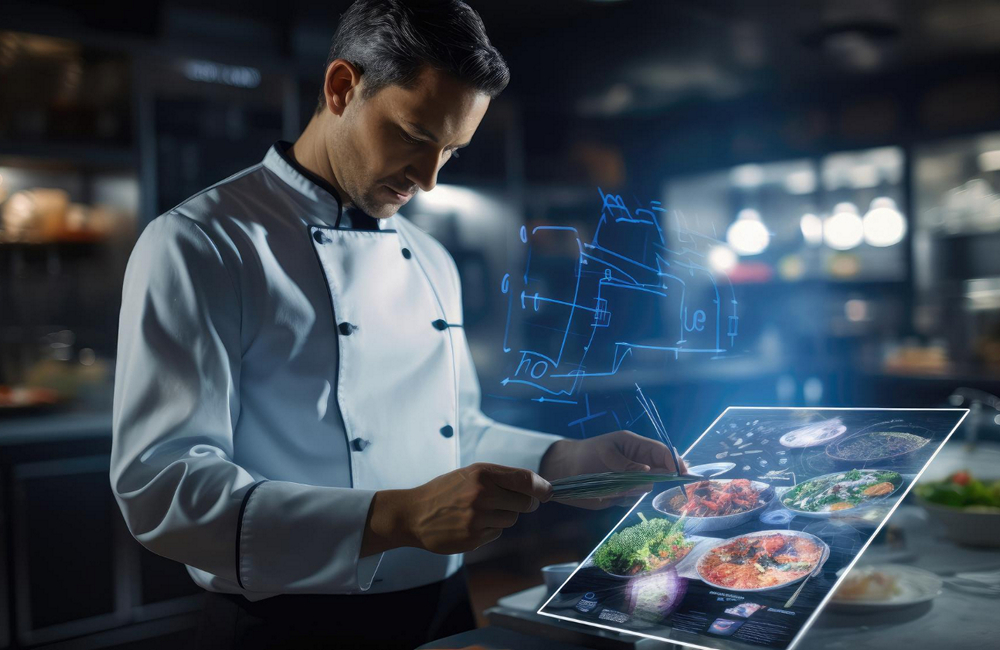Amidst a world reshaped by the pandemic, shifting labor markets, and changing consumer behaviors, restaurant proprietors are increasingly embracing technological advancements. These often inconspicuous yet profoundly impactful innovations are quietly revolutionizing culinary practices and guest interactions. Whether it's the integration of AI-driven analytics to refine menu offerings or the precision of robotics streamlining kitchen processes, a new era in dining is emerging.
As the fusion of technology and gastronomy continues to unfold, the dining landscape undergoes transformation across all sectors, spanning from the rapid pace of quick-service establishments to the leisurely ambiance of family-oriented dining. Despite the challenges encountered within each sector, the ultimate objective remains consistent: to craft dining experiences that resonate with patrons long after their departure from the table.

Quick Service Restaurants (QSR)
A quick-service restaurant, often referred to as a fast-food establishment, efficiently serves meals with minimal table service, known as takeout or takeaway restaurants in various countries. Ideal for those on the go or students looking for a quick bite between classes, these establishments have become a staple in the restaurant industry. With diverse offerings, there are four main types of QSRs based on the kind of food they specialize in, including hamburger joints, pizza parlors, fried chicken stands, and sandwich shops.
These restaurants cater to the demand for affordable, convenient food options that can be easily picked up on the go. Characterized by a simple POS system, a limited menu, and counter or drive-thru ordering, QSRs have evolved to meet the changing preferences of customers. A well-designed QSR that prioritizes workflow optimization and efficient customer flow is positioned to thrive in a market that exceeded $382 million in 2022, a notable increase from the previous year's total of $322.05 billion. To keep up with this growth-driven market, integrating the latest smart kitchen configurations and streamlined service zones can significantly reduce order processing times.
Behind the scenes, prioritizing employee well-being is essential. Carefully crafted scheduling, proactive management, and ongoing training synergize staff efforts within the dynamic QSR landscape, ensuring teams are in sync with business objectives and adapting to evolving demands.
Fast-Casual Dining
Fast-casual restaurants play a pivotal role in embracing mainstream trends and adapting to modern technology. To stay relevant and competitive in the market, innovation and trend awareness are crucial. Here are five ways to ensure your fast-casual restaurant remains aligned with current trends:
-
Ordering Systems: With the increasing popularity of online food services like Grubhub, Doordash, and Uber Eats, developing an efficient online ordering system is essential. Utilizing these platforms and creating a dedicated app can foster healthy competition within the industry and enhance customer convenience.
-
Reserving Tables Online: Transitioning from traditional table reservation methods to online reservations has become the new norm. Platforms like Eat App, Wisely, and OpenTable can effectively manage waitlists, seating arrangements, and dining preferences. Implementing such systems prevents friction within the dining area and ensures customer satisfaction.
-
Automated Inventory Management (A.I.M): Leveraging automated inventory management is an efficient way to track and manage restaurant inventory. A.I.M utilizes artificial intelligence to streamline order scheduling, reduce food wastage, and optimize overall inventory practices. This technology not only saves time and money but also contributes to the sustainability of the industry.
-
Contactless Payment: The advent of contactless payment methods, especially after the events of 2020, has transformed the payment landscape. Smartwatches, cash cards, and various apps now offer convenient and secure payment options. Investing in contactless payment solutions is essential to cater to evolving consumer preferences and is predicted to boost profits in the coming years.
Adopting these technological advancements will not only keep your fast-casual restaurant in sync with contemporary trends but also provide a competitive edge in the ever-evolving restaurant landscape.

Casual Dining
In the contemporary casual dining sector, the emphasis is on seamlessly integrating operational efficiency with a warm and inviting ambiance. Casual dining establishments prioritize efficient behind-the-scenes operations alongside creating a front-end setting that radiates comfort and encourages patrons to linger.
To achieve these goals, venues are adopting advanced POS systems that transcend basic transaction processing. These systems efficiently manage orders, allocate tables, and provide real-time inventory tracking, minimizing wait times and preventing stock shortages. Additionally, these digital tools incorporate features that enable personalized service, such as remembering regular customers' preferences and suggesting menu items based on past choices.
Another notable advancement in casual dining is the widespread adoption of sous vide cooking techniques. This precise cooking method, involving a controlled water bath, ensures consistent results, reduces errors, minimizes food waste, and enhances the flavor and texture of dishes. This allows chefs to focus more on the creative and artistic aspects of their culinary creations.
In the dynamic landscape of casual dining, establishments are not only enhancing customer convenience but also exploring new revenue avenues. The introduction of self-service drink stations and meal subscription offers exemplifies this strategic approach. Self-service drink stations cater to the growing demand for quick and personalized service, while meal subscriptions provide a recurring revenue model that aligns with the convenience dining trend. These forward-thinking additions showcase how casual dining is leveraging technology to expand its business model, ensuring both customer satisfaction and increased profitability.
Final Thoughts
In the ongoing evolution of the restaurant industry, technology plays a pivotal role in reshaping customer experiences, streamlining kitchen operations, and promoting sustainability. The adoption of these technological advancements is imperative for restaurants seeking to stay competitive, provide exceptional service, and contribute to a sustainable future.
This transition signifies a departure from conventional dining practices toward a new era characterized by immersive experiences, efficient operations, and decisions informed by data. Embracing these changes positions restaurants at the forefront of innovation, ensuring they remain relevant and responsive to the evolving needs and expectations of their patrons.


